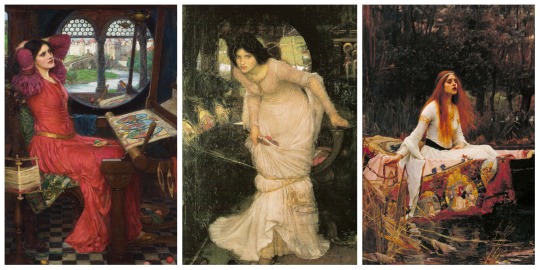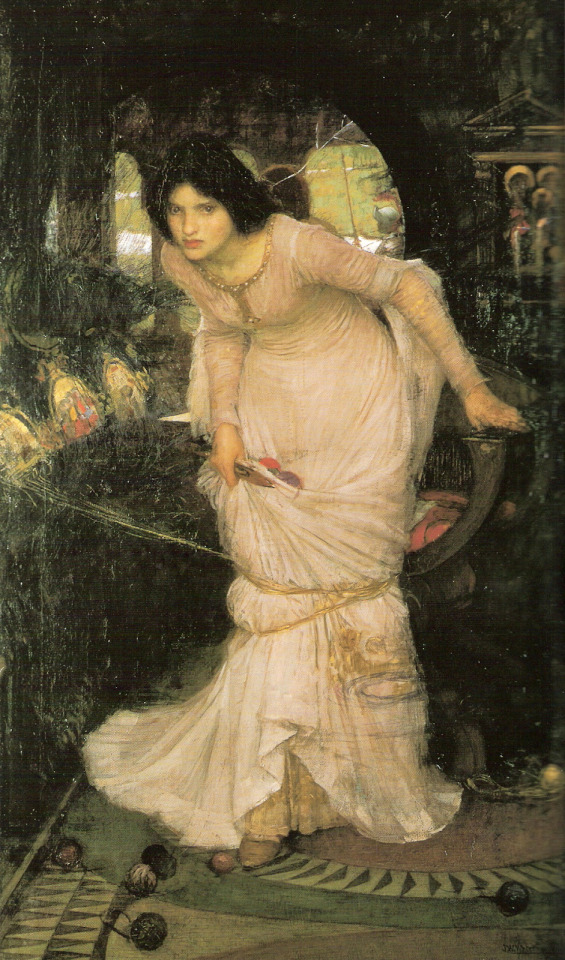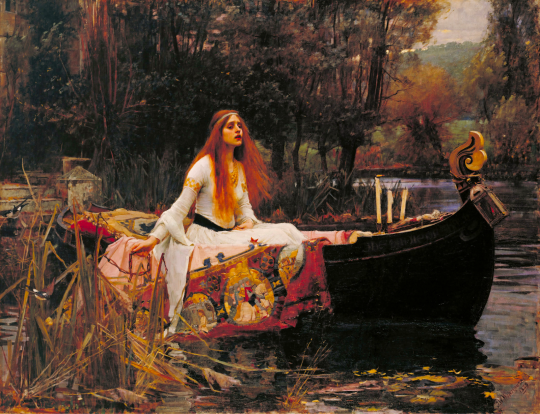#I guess I must miss uni since I felt like writing a literary analysis
Text
The Lady of Shalott and Elain Archeron
This will be a comparative analysis of Alfred Tennyson’s poem The Lady of Shalott (1842), three paintings by Waterhouse, and Elain Archeron (because why not?)
I recently read The Lady of Shalott for the first time in years and I couldn’t help but see the similarities between the character in Tennyson’s poem and Elain, so I decided to write this analysis since I love both the poem, the art and our flower girl. There will also be mentions of Elriel.

Synopsis:
In short, the poem tells the story of the Lady of Shalott, also known as Elaine of Astolat (very fitting name…).
In the beginning of this Victorian poem, we are introduced to the Lady (this is what I will call her in this text) and the setting. We are told that she is cursed (but we do not know what the curse really is). She is locked in a tower and not allowed to look out the window. Instead, she has a mirror that reflects the world outside. She watches the world through that mirror and weaves what she sees.
In the middle of the poem, the Lady sees a handsome man in her mirror - Lancelot. And for the first time in her life, she turns around to look out the window to behold him. The mirror cracks and the Lady knows that the curse is upon her.
She runs out of the tower and writes her name on a small boat. Knowing that she is cursed, she gets in the boat and lets it float away, and there, on the river, she dies a peaceful death. When the boat enters Camelot, Lancelot sees her face and says, "She has a lovely face; God in his mercy lend her grace, The Lady of Shalott."
1. I am half sick of shadows / To see what cannot be seen

This painting by Waterhouse is called “I am half sick of Shadows, said the Lady of Shalott.”
In this stanza, we can see where Waterhouse found his inspiration:
But in her web she still delights
To weave the mirror's magic sights,
For often thro' the silent nights
A funeral, with plumes and lights
And music, went to Camelot:
Or when the moon was overhead,
Came two young lovers lately wed:
"I am half sick of shadows," said
The Lady of Shalott.
As previously mentioned, the Lady is cursed and forced to sit in her tower and weave what she sees in the mirror. She had no companions and is doomed to spend her life alone, watching but never participating in life. In Waterhouse’s painting, we can see two lovers reflected in the mirror. Something that is worth noting is that we can also see a red poppy in the mirror (at the bottom, by her loom), but the flower cannot be seen in the foreground. The red poppy symbolizes eternal sleep and foreshadows her fate.
In the poem, it is clear that the Lady is tired of only seeing the shadows of reality. This image of the lady locked in a tower can represent the Victorian ideal of the ideal woman: virginal, mysterious and dedicated to womanly tasks. She is a passive object.
Elain:
At the beginning of ACOWAR, Elain spends most of her time in her room in the House of Wind. She looks out the window, maybe looking for the life she was forced to leave behind? She sees herself as cursed after being forced into the cauldron. Her curse is that she can see things others cannot. Her mind produces images that make no sense to her and the people around her wonder if she might be broken. She does not participate in ordinary life and her life is only a shadow of what it once was. She was engaged to be married to a man she thought she loved who loved her back. Now, she’s forced to watch happy couples and happy people when she herself is miserable. Her mate’s attempts to get her attention are not making things better.
We later find out that Elain is a seer, which brings my attention back to the poppy. The Lady is only allowed to look in the mirror and there, she can see her fate in the small flower. She can see her curse - just like Elain can see things that haven't happened yet. Maybe she can also see her own curse?
Just like the Lady of Shalott, Elain has been called passive. People accuse her of not ‘doing anything’ and that she is boring because she enjoys ‘womanly tasks’. And yes, in the beginning of ACOWAR, she was more passive, which can be explained by the fact that she did not understand her own mind.
2. The mirror crack'd from side to side / To see or be seen

In this painting, The Lady of Shalott looking at Lancelot, we can see the cracked mirror in the background. The Lady is looking right at us and she is tangled in the threads of her tapestry. One could also see this as the Lady being tangled in the threads of her own fate. In the mirror, we can also see Lancelot as he rides by.
In the poem, the Lady sees Lancelot and falls in love instantaneously. In the following stanza, we can see the Lady’s reaction to seeing the handsome knight:
She left the web, she left the loom,
She made three paces thro' the room,
She saw the water-lily bloom,
She saw the helmet and the plume,
She look'd down to Camelot.
Out flew the web and floated wide;
The mirror crack'd from side to side;
"The curse is come upon me," cried
The Lady of Shalott.
Here, the lady is no longer passive. She is actively “choosing to defy her confinement, in pursuit of her own desires” (see source). As soon as she turns, the mirror cracks and she knows that the curse is upon her. She knew that the curse would come, yet she decided to go against everything she knew and believed, just for a glance of the man she loved.
In Victorian times, this might have been seen as the lady being cursed for giving up on her ideals. She, and women in general, were supposed to be virginal, passive and obedient. When she looks out that window to look at Lancelot, she is leaving these ideals behind. She is now a woman actively choosing her own path and being in control of her own sexuality. She is longing for something, for someone, and she allows herself to go after what she wants - even if it might destroy her.
Elain:
In ACOWAR, Elain is also drawn to a particular man/male - Azriel. She lets him carry her and take her out to the garden and when she sees his hands/siphons, she tells him that they’re beautiful. This is Elain being more active than passive. She is talking to Azriel, engaging with him.
Everyone else thinks that she is cursed and that there’s something wrong with her (Feyre calls Madja to examine Elain, Lucien tries to feel what is wrong with her through the mating bond and Nesta guards Elain at all times). Everyone is protective of Elain, even though they don’t understand her. They don’t truly see her. Like when she asks Lucien “I can hear your heart. Can you hear mine?” and he answers that he cannot. Here, one might interpret this as if Elain knows what’s in Lucien’s heart, but he does not know what’s in her heart. Her fate is tied to Lucien, yet he does not see her truth.
Then, one person does see her. Azriel is the one who figures out that Elain is a seer and as soon as he utters those words, something changes. Elain has been isolating (just like the Lady), seeing things only as shadows (just like the Lady of Shalott) and she is changed after someone actually sees her. And after that, she can see herself more clearly. She can understand her curse.
In the poem, the Lady understands her curse after she sees Lancelot. Although he does not see her in her tower, she decided to defy her fate because of the love she felt for Lancelot. And by leaving the tower, she is also making herself seen. She is not hidden in the shadows anymore and she is not afraid of what’s to come. She is actively making her own choices - even if they mean death.
After Azriel tells her that she is a seer, Elain takes on a more active role. She, too, goes from passive to active. She, too, defies her fate. She tells Feyre that she does not want a mate. She joins the battle against Hybern. She kills the King of Hybern.
She is tangled in the threads of her fate – her past where she was engaged to Graysen, her present where she is tied to Lucien, and her future that is yet to be written. But now, she can be an active participant in what her future will be. In ACOFAS, we see Elain dismiss Lucien in favor of spending an entire evening with Azriel, where she tells him about her plans for the garden. Before that, Azriel helps her carry a tray of potatoes. They see each other - and they are actively seeking out each other’s company - even though they shouldn’t.
3. Like some bold seër in a trance / See me

First and foremost, when the Lady leaves the tower and sits down in the boat, she looks toward Camelot and Tennyson describes her like this: Like some bold seër in a trance. Which is…interesting.
In this last part of the poem, the Lady flees the tower and finds a boat that can take her to Camelot. In Waterhouse’s painting, we can see the tapestry she has woven draped over the boat (in the smaller images on the tapestry we can see the lady herself and Lancelot surrounded by other knights).
On the boat, we can also see a crucifix (which symbolizes sacrifice) and three candles - two have been blown out already, which might indicate that her life is about to end. She is just about to let go of the chain and let the boat take her to Camelot - to Lancelot. And on her journey, she dies.
This is the last stanza of the poem:
Who is this? and what is here?
And in the lighted palace near
Died the sound of royal cheer;
And they cross'd themselves for fear,
All the knights at Camelot:
But Lancelot mused a little space;
He said, "She has a lovely face;God in his mercy lend her grace, The Lady of Shalott."
When she reaches Camelot, she is already dead. The other knights “cross’d themselves for fear” but Lancelot looks at her and “muses a little space” and sends a prayer her way. And he is also probably the first person to ever say her name. Although she is dead, she can finally be seen. She can finally be a part of the outside world. And in death, her love saw her.
One can analyze this poem in many ways. You might read it and think about the woman’s role in Victorian society and therefore see the theme as “freedom comes at a cost” - Yes, the Lady found her freedom, but as soon as she left her ‘morals’ behind, she died.
One can also focus on the isolation the Lady of Shalott was subjected to. The harm of this isolation broke her and she eventually chose death just to get out of her loneliness (=one of my favorite interpretations).
And then, for the sake of this analysis, I also want to bring up a different interpretation: “The Lady of Shalott's escape from her tower as an act of defiance, a symbol of female empowerment” (see source; Christine Poulson).
In this last interpretation, the Lady is breaking free from the norms and chains holding her hostage in a life she does not want. The lady is also coming to terms with her own female sexuality. Christine Poulson also writes that “the depiction of death has also been interpreted as sleep” and goes on to explain that sleep “has a connotation of physical abandonment and vulnerability, which can either suggest sexual fulfillment or be a metaphor for virginity.”
Elain:
Firstly, just like the Lady of Shalott, Elain has been told that she has “a lovely face” her entire life. This is something that defines her - she is the most beautiful sister. And as mentioned previously, Azriel is the first to truly see Elain, just like Lancelot is the first to truly see the Lady.
Now, I do not think that Elain will lay down in a boat and die. But I do see the similarities between Elain and the Lady of Shalott here, especially when considering this last interpretation above. When the Lady leaves the tower and ‘dies’ this can be interpreted as sexual fulfillment. As mentioned earlier, the Lady goes from passive to active - actively choosing to act on her feelings for Lancelot.
And as we can see in The Bonus Chapter from ACOSF (Azriel’s POV), Elain is also actively going after the man she wants. He is not what fate/the cauldron has chosen for her, but he is what she has chosen for herself.
When he bends down to kiss her, Elain gives him “offer and permission”. She wants him. She yearns for him. She is aroused by him. By choosing him, she is leaving her old life as a human behind. She told Feyre that she doesn’t want a mate or a male, showing the readers that she was still mourning her human life. She wanted a man, not a male. Yet here she is, choosing a male that is not her mate. She is not only leaving her human life behind, she is also defying the life fate chose for her.
In the poem, the lady dies because the curse was upon her. Yet, we still don’t know what this curse was. Was it really that she would die if she looked out that window? Or was the real curse knowing that she couldn’t have what she wanted?
In the legend, we can read about Lancelot’s love for Guinevere (who is married to King Arthur) and Elaine of Astolat therefore died of a broken heart. Her curse was to love but never being loved in return. She sacrificed everything for him, only to find that he loved someone else.
In the Bonus Chapter, Azriel leaves Elain in the hallway. She doesn't know why, but we can assume that she feels as though her love wasn’t returned. She told Azriel, with her words and her body, that she wanted him. Still, Azriel left, abandoning her. Leaving her alone, once again. Maybe Elain wonders if her curse is also to love but never being loved in return?
No, Elain will not die from this, but there are certainly similarities between the two stories. I think, most importantly, that both Elain Arechron and Elaine of Astolat were women who didn’t have much choice. Their fate had been decided by some higher power and they had to look and act like good women. They were passive objects. Then, when they find love, they will do anything to make their own decisions. They turn into active subjects. They will do whatever it takes to get the love they want – the love they deserve. They will break the rules and the threads of fate, even if they're just given the smallest glimpse of what life could be like. They are holding onto hope - wishing for the life they so desperately want.
Freedom is the ultimate goal for both women.
Freedom to be who they want to be.
Freedom to live the life they want to live.
Freedom to love the man they want to love.
And freedom to make their own choices, fate be damned!
#elain archeron#pro elain#pro elriel#I guess I must miss uni since I felt like writing a literary analysis#I hope it makes sense#re-upload because tumblr was messing with me yesterday
49 notes
·
View notes